The Energy Saving Potential of Occupancy-Based Lighting Control Strategies in Open-Plan Offices: The Influence of Occupancy Patterns
Abstract
:1. Introduction
2. Methodology
2.1. The Model
2.1.1. Modeling Techniques
2.1.2. Model Setup
2.1.3. Occupancy Generation
2.1.4. Data Aggregation
2.1.5. Data Presentation
2.2. Simulations
2.2.1. Validating the Model
2.2.2. Assessing the Influence of Occupancy Pattern Variance
3. Results
3.1. Validating the Model
3.1.1. Occupancy Patterns
3.1.2. Relationship between Occupancy Spread, Lighting Energy Use, and Average Occupancy
3.1.3. Convergence Analysis
3.2. Assessing the Influence of Occupancy Pattern Variance
3.3. Determining the Relevant Control Zone Size for the Office Cases
4. Discussion
4.1. Validating the Model
4.2. Assessing the Influence of Occupancy Pattern Variance
4.3. Determining the Relevant Control Zone Size for the Office Cases
4.4. Limitations
4.5. Future Research Directions
5. Conclusions
Acknowledgments
Author Contributions
Conflicts of Interest
References
- Commission, E. 2050 Energy Strategy. Available online: https://ec.europa.eu/energy/en/topics/energy-strategy-and-energy-union/2050-energy-strategy (accessed on 20 June 2017).
- Ryckaert, W.R.; Lootens, C.; Geldof, J.; Hanselaer, P. Criteria for energy efficient lighting in buildings. Energy Build. 2010, 42, 341–347. [Google Scholar] [CrossRef]
- Shur, M.; Zukauskas, R. Solid-state lighting: Toward superior illumination. Proc. IEEE 2005, 93, 1691–1703. [Google Scholar] [CrossRef]
- Wang, Q.; Zhang, X.; Boyer, K.L. Occupancy distribution estimation for smart light delivery with perturbation-modulated light sensing. J. Solid State Light. 2014, 1, 17. [Google Scholar] [CrossRef]
- Chung, T.M.; Burnett, J. On the Prediction of Lighting Energy Savings Achieved by Occupancy Sensors. Energy Eng. 2009, 98, 6–23. [Google Scholar] [CrossRef]
- Galasiu, A.D.; Newsham, G.R.; Suvagau, C.; Sander, D.M. Energy Saving Lighting Control Systems for Open-Plan Offices: A Field Study. LEUKOS 2013, 4, 7–29. [Google Scholar]
- Von Neida, B.; Manicria, D.; Tweed, A. An Analysis of the Energy and Cost Savings Potential of Occupancy Sensors for Commercial Lighting Systems. J. Illum. Eng. Soc. 2001, 30, 111–125. [Google Scholar] [CrossRef]
- Bellia, L.; Fragliasso, F. New parameters to evaluate the capability of a daylight-linked control system in complementing daylight. Build. Environ. 2017, 123, 223–242. [Google Scholar] [CrossRef]
- Rossi, M.; Pandharipande, A.; Caicedo, D.; Schenato, L.; Cenedese, A. Personal lighting control with occupancy and daylight adaptation. Energy Build. 2015, 105, 263–272. [Google Scholar] [CrossRef]
- Caicedo, D.; Li, S.; Pandharipande, A. Smart lighting control with workspace and ceiling sensors. Light. Res. Technol. 2017, 49, 446–460. [Google Scholar] [CrossRef]
- Pandharipande, A.; Caicedo, D. Smart indoor lighting systems with luminaire-based sensing: A review of lighting control approaches. Energy Build. 2015, 104, 369–377. [Google Scholar] [CrossRef]
- Chew, I.; Karunatilaka, D.; Tan, C.P.; Kalavally, V. Smart lighting: The way forward? Reviewing the past to shape the future. Energy Build. 2017, 149, 180–191. [Google Scholar] [CrossRef]
- Rubinstein, F.; Enscoe, A. Saving energy with highly-controlled lighting in an open-plan office. LEUKOS 2010, 7, 21–36. [Google Scholar] [CrossRef]
- Fernandes, L.L.; Lee, E.S.; DiBartolomeo, D.L.; McNeil, A. Monitored lighting energy savings from dimmable lighting controls in The New York Times Headquarters Building. Energy Build. 2014, 68, 498–514. [Google Scholar] [CrossRef]
- Duarte, C.; Van Den Wymelenberg, K.; Rieger, C. Revealing occupancy patterns in an office building through the use of occupancy sensor data. Energy Build. 2013, 67, 587–595. [Google Scholar] [CrossRef]
- Bouffaron, P. Revealing Occupancy Diversity Factors in Buildings Using Sensor Data. In Proceedings of the Behavior, Energy and Climate Change Conference, Washington, DC, USA, 7–10 December 2014. [Google Scholar]
- Chang, W.; Hong, T. Statistical analysis and modeling of occupancy patterns in open-plan offices using measured lighting-switch data. Build. Simul. 2013, 6, 23–32. [Google Scholar] [CrossRef]
- De Bakker, C.; Aries, M.; Kort, H.; Rosemann, A. Occupancy-based lighting control in open-plan office spaces: A state-of-the-art review. Build. Environ. 2017, 112, 308–321. [Google Scholar] [CrossRef]
- Creemers, P.T.J.; van Loenen, E.J.; Aarts, M.P.J.; Chraibi, S.; Lashina, T.A. Acceptable fading time of a granular controlled lighting system for co-workers in an open office. In Proceedings of the Experiencing Light 2014: International Conference on the Effects of Light on Wellbeing, Eindhoven, The Netherlands, 10–11 November 2014; p. 70. [Google Scholar]
- Roisin, B.; Bodart, M.; Deneyer, A.; D’Herdt, P. Lighting energy savings in offices using different control systems and their real consumption. Energy Build. 2008, 40, 514–523. [Google Scholar] [CrossRef]
- Jennings, J.; Colak, N.; Rubinstein, F. Occupancy and time-based lighting controls in open offices. J. Illum. Eng. Soc. 2002, 31, 86–100. [Google Scholar] [CrossRef]
- Rubinstein, F.; Bolotov, D.; Levi, M.; Powell, K.; Schwartz, P. The Advantages of Highly Controlled Lighting for Offices and Commercial Buildings. In Proceedings of the 2008 ACEEE Summer Study on Energy Efficiency in Buildings, Pacific Grove, CA, USA, 17–22 August 2008. [Google Scholar]
- Feng, X.; Yan, D.; Hong, T. Simulation of occupancy in buildings. Energy Build. 2015, 87, 348–359. [Google Scholar] [CrossRef]
- Davis, J.A.; Nutter, D.W. Occupancy diversity factors for common university building types. Energy Build. 2010, 42, 1543–1551. [Google Scholar] [CrossRef]
- ANSI/ASHRAE/IESNA. ASHRAE Standard 90.1-2016. Energy Standard for Buildings Except Low-Rise Residential Buildings; ASHRAE/IES/ANSI: Atlanta, GA, USA, 2016. [Google Scholar]
- Virote, J.; Neves-Silva, R. Stochastic models for building energy prediction based on occupant behavior assessment. Energy Build. 2012, 53, 183–193. [Google Scholar] [CrossRef]
- Ahn, K.-U.; Park, C.S. Different Occupant Modeling Approaches for Building Energy Prediction. Energy Procedia 2016, 88, 721–724. [Google Scholar] [CrossRef]
- Gaetani, I.; Hoes, P.-J.; Hensen, J.L.M. Occupant behavior in building energy simulation: Towards a fit-for-purpose modeling strategy. Energy Build. 2016, 121, 188–204. [Google Scholar] [CrossRef]
- Cowles, M.K.; Carlin, B.P. Markov Chain Monte Carlo Convergence Diagnostics: A Comparative Review. J. Am. Stat. Assoc. 1996, 91, 883–904. [Google Scholar] [CrossRef]
- European Committee for Standardization. EN 12464-1:2011 Light and Lighting—Lighting of Work Places—Part 1: Indoor Work Places; CEN: Brussels, Belgium, 2011. [Google Scholar]
- De Bakker, C.; Aries, M.; Helianthe, K.; Rosemann, A. Occupants’ behaviour: An observation study for energy saving potential on lighting. In Proceedings of the BEHAVE 2016 4th European Conference on Behaviour and Energy Efficiency, Coimbra, Portugal, 8–9 September 2016. [Google Scholar]


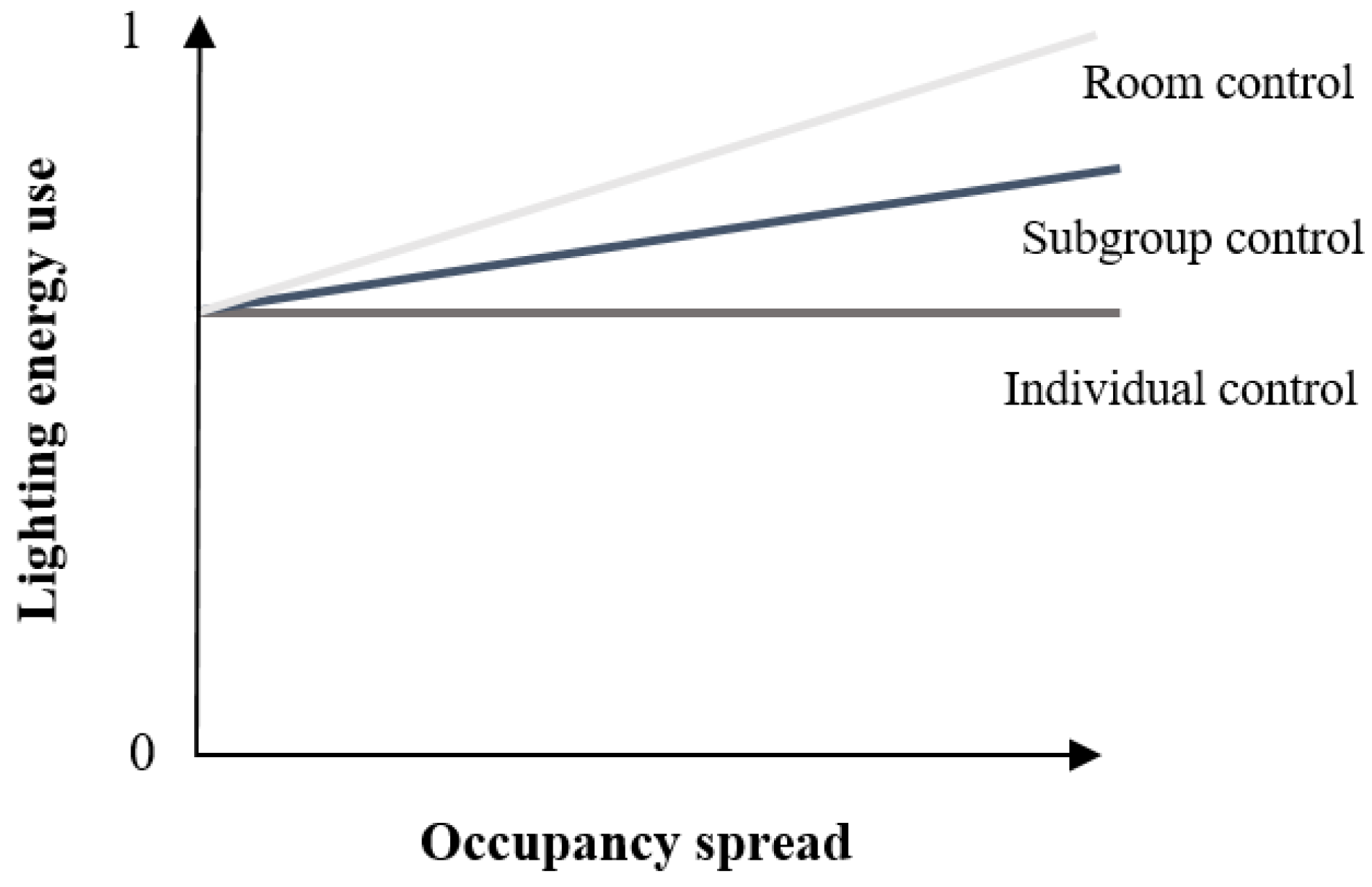



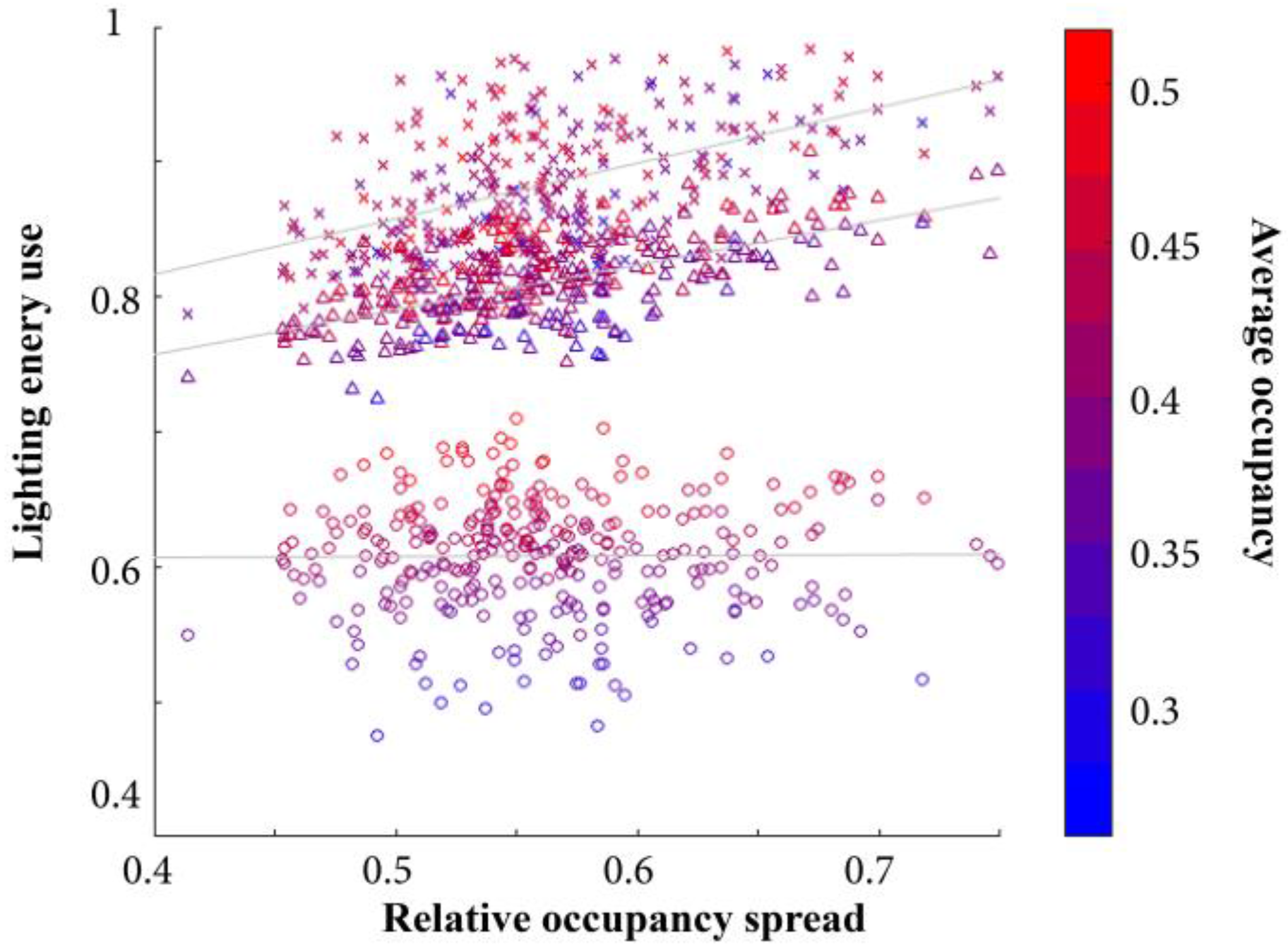

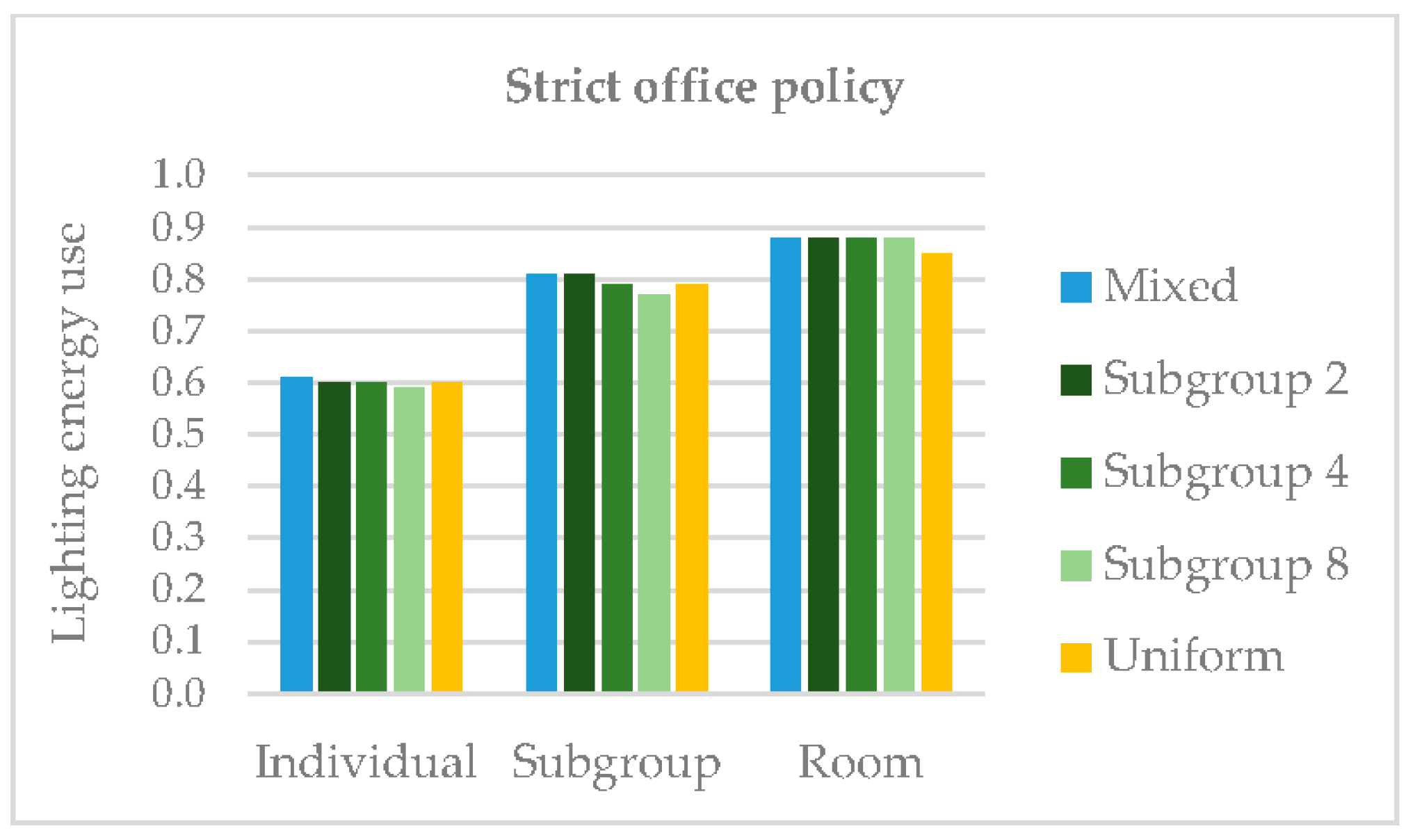
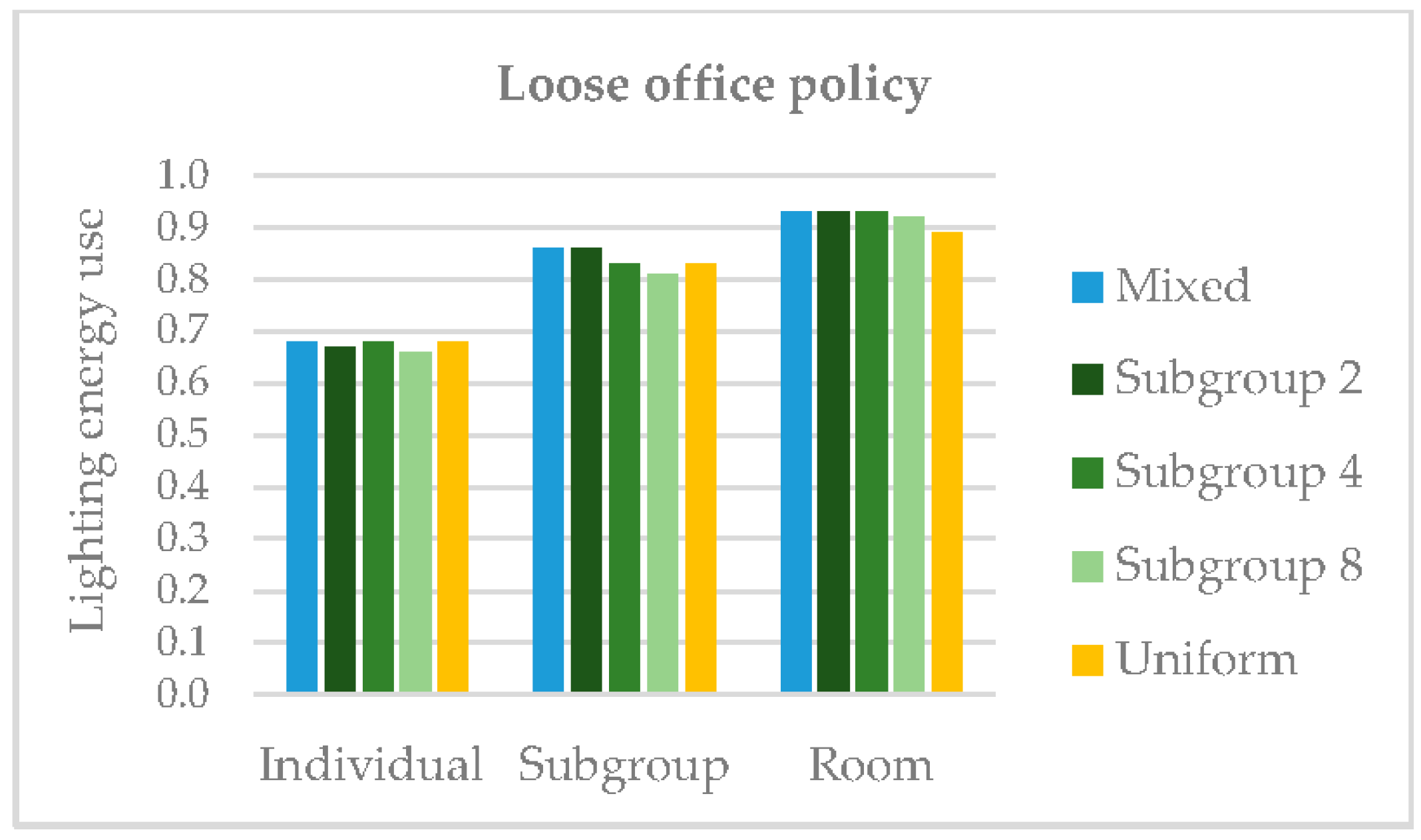
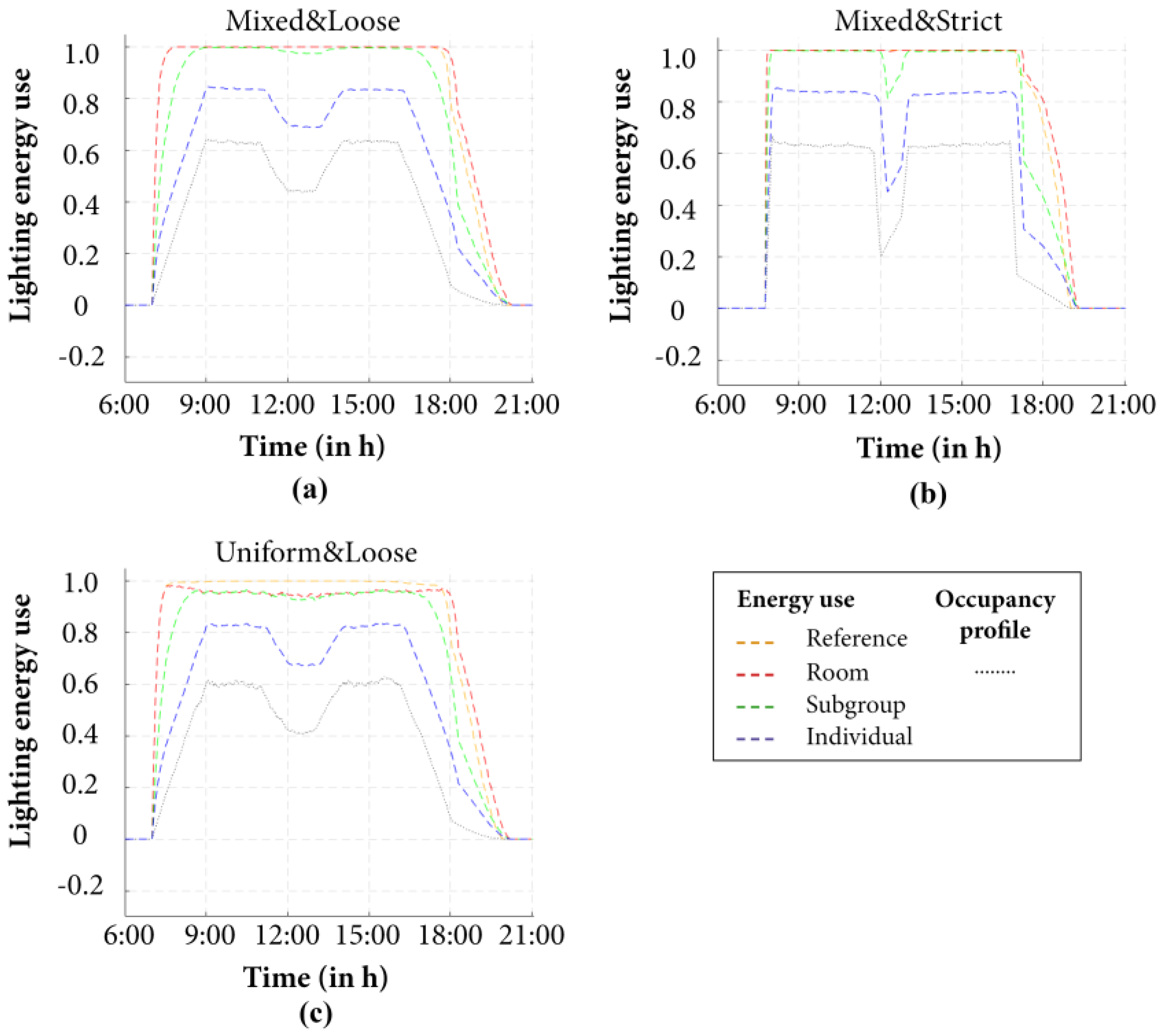
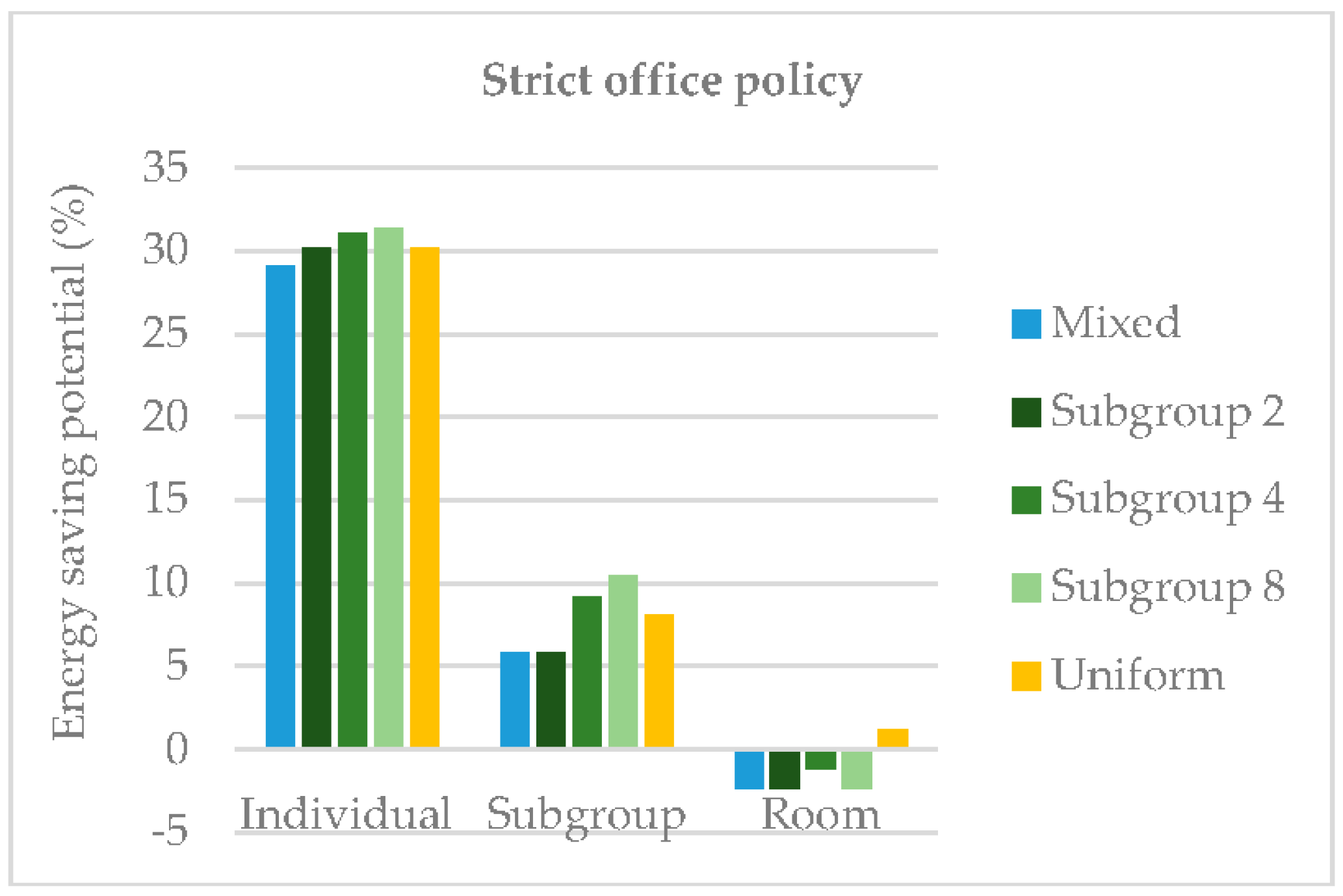
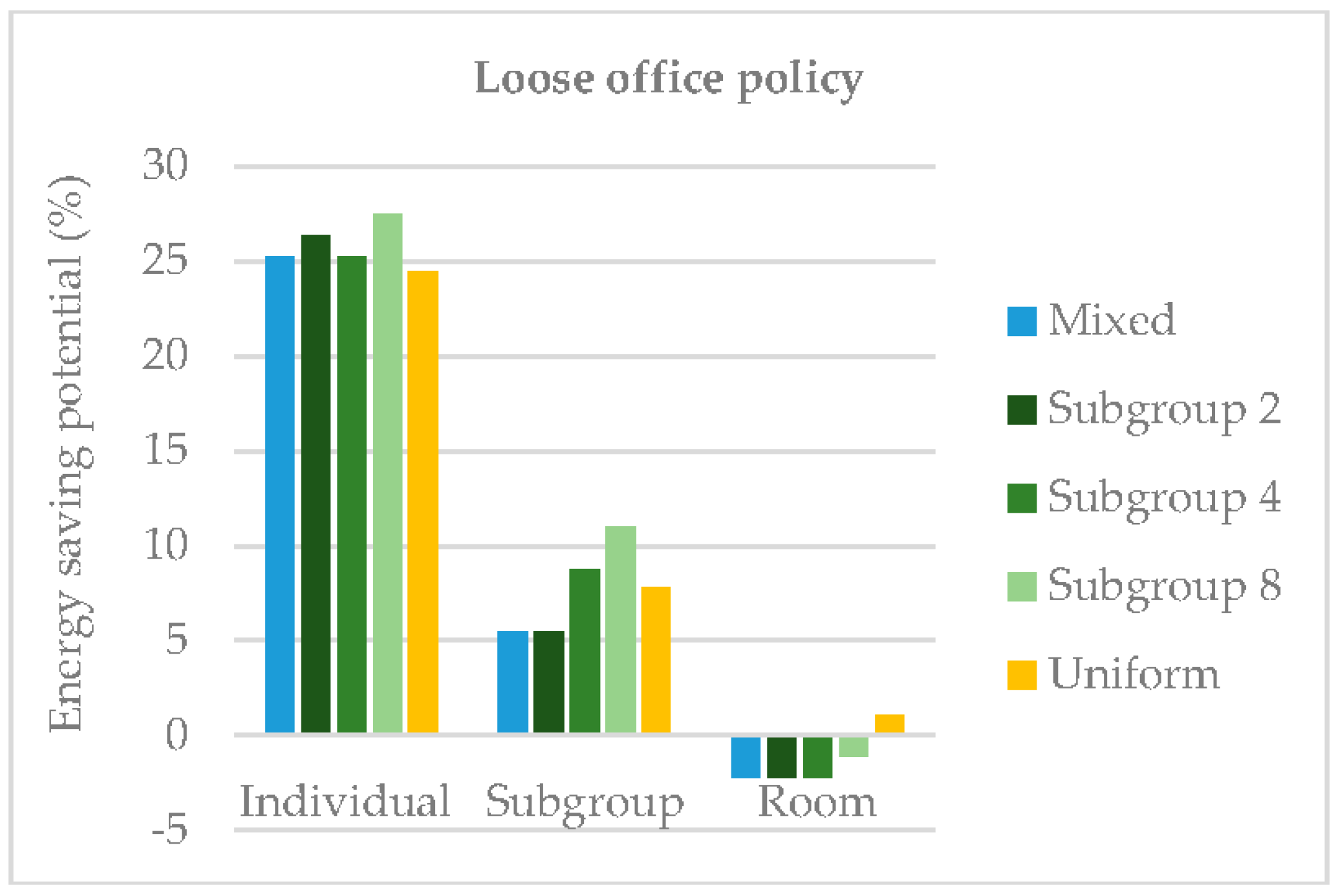
| Category | Input Parameters |
|---|---|
| Job-function type | Number of absence events |
| Length of absence events | |
| Special absences | Number of holidays |
| Number of sick days | |
| FTE | |
| Office policy | Start time |
| Chance of overtime | |
| Length of overtime | |
| Number of working hours | |
| Lunch length | |
| Absence type | Ratio between individual and group absence events |
| Lighting system settings | Dimming level |
| Inactivity timer | |
| Control zone size |
| Job-Function Type | Number of Absences per Duration Category (in Minutes) | ||||||
|---|---|---|---|---|---|---|---|
| 0–5 | 5–15 | 15–30 | 30–60 | 60–90 | 90–120 | 120–240 | |
| Manager | 15 | 7 | 3 | 1.3 | 0.5 | 0.3 | 0.12 |
| Secretary | 8 | 4 | 0.5 | 0.8 | 0 | 0 | 0 |
| Designer | 25 | 4 | 1 | 0.3 | 0 | 0 | 0 |
| Drafter | 20 | 6 | 0.07 | 0.3 | 0.2 | 0 | 0 |
| Helpdesk employee | 10 | 5 | 0.2 | 0.4 | 0.1 | 0.05 | 0.05 |
| Team leader | 20 | 6 | 2 | 0.2 | 0.1 | 0.2 | 0.1 |
| Sales representative | 12 | 4 | 1 | 0.45 | 0.3 | 0.3 | 0.3 |
| Consultant | 10 | 6 | 1 | 0.2 | 0.1 | 0.4 | 0.6 |
| Category | Input Parameters | Loose Policy | Strict Policy |
|---|---|---|---|
| Office policy | Start time | 7:00 a.m.–9:00 a.m. | 7:45 a.m.–8: 00 a.m. |
| Chance of overtime | 0.2 | 0.2 | |
| Length of overtime | 1 h | 1 h | |
| Number of working hours | 8 | 8 | |
| Lunch length | 0.75 h | 0.75 h | |
| Lunch start | 3.5–4.5 h | 4 h |
| Function Type | Function Type Distributions | ||||
|---|---|---|---|---|---|
| Mixed | Subgroup 2 | Subgroup 4 | Subgroup 8 | Uniform | |
| Manager | 1 | 2 | 4 | 8 | 0 |
| Secretary | 1 | 2 | 4 | 8 | 0 |
| Designer | 4 | 2 | 0 | 0 | 0 |
| Drafter | 2 | 2 | 4 | 0 | 0 |
| Helpdesk employee | 2 | 2 | 0 | 0 | 0 |
| Team leader | 3 | 2 | 4 | 0 | 16 |
| Sales representative | 1 | 2 | 0 | 0 | 0 |
| Consultant | 2 | 2 | 0 | 0 | 0 |
| Number of different function types | 8 | 8 | 4 | 2 | 1 |
© 2017 by the authors. Licensee MDPI, Basel, Switzerland. This article is an open access article distributed under the terms and conditions of the Creative Commons Attribution (CC BY) license (http://creativecommons.org/licenses/by/4.0/).
Share and Cite
De Bakker, C.; Van de Voort, T.; Rosemann, A. The Energy Saving Potential of Occupancy-Based Lighting Control Strategies in Open-Plan Offices: The Influence of Occupancy Patterns. Energies 2018, 11, 2. https://doi.org/10.3390/en11010002
De Bakker C, Van de Voort T, Rosemann A. The Energy Saving Potential of Occupancy-Based Lighting Control Strategies in Open-Plan Offices: The Influence of Occupancy Patterns. Energies. 2018; 11(1):2. https://doi.org/10.3390/en11010002
Chicago/Turabian StyleDe Bakker, Christel, Tom Van de Voort, and Alexander Rosemann. 2018. "The Energy Saving Potential of Occupancy-Based Lighting Control Strategies in Open-Plan Offices: The Influence of Occupancy Patterns" Energies 11, no. 1: 2. https://doi.org/10.3390/en11010002





